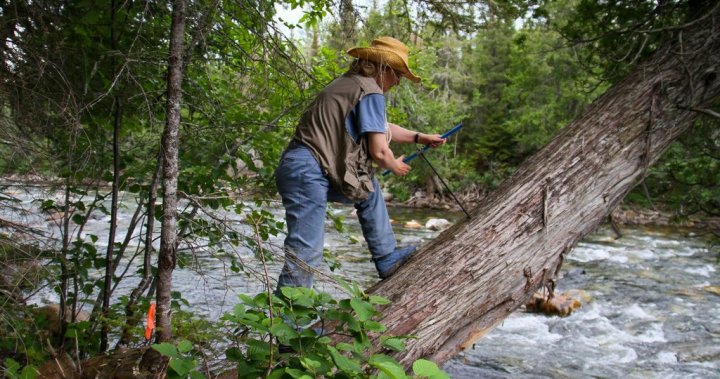Quebec tree rings dating back nearly 200 years indicate snowpack in the Gaspésie mountains has declined considerably in recent decades, Concordia University researchers suggest in a study that could give further insight into dwindling caribou herds and hydro energy forecasts.
The tree ring study goes back to 1822, extending by more than 100 years the records otherwise kept by local weather stations and river gauges. It underlines how climate change has already reshaped the region, the study said.
“This reconstruction may prove useful for wildlife, fisheries and hydroelectric reservoir management,” said the study, published in Journal of Hydrology: Regional Studies.
By studying the tree rings in the Sainte-Anne River basin, the researchers say they observed a climate-change linked decline in extreme spring river flows and snowpack levels since 1937.
“The system was at a tipping point, and it didn’t take much global warming to push it to where we’ve lost the extreme snowpacks the mountains used to have,” said Jeannine-Marie St-Jacques, the study’s co-author and an associate professor at Concordia University in Montreal.
The results, the study said, offer more long-term context for the “highly endangered” caribou population on the Gaspé Peninsula, the last herd south of the St. Lawrence River. The population has collapsed since the 1950s from estimates as high as 1,500 to 34, according to government figures.
Habitat degradation from logging is considered the caribou’s most pressing threat but declining snowpack adds to their problems, researchers say. Caribou breed in the alpine and deep snowpack can offer protection from predators.
“When there’s less snow, there’s easier access for predators to get up there early in the spring when the fawns are more vulnerable,” said Alexandre Pace, the study’s lead author and a PhD candidate at Concordia.

Get daily National news
Get the day’s top news, political, economic, and current affairs headlines, delivered to your inbox once a day.
The longer timeline of spring river flows can also help inform energy forecasts for Quebec’s multi-billion-dollar hydroelectricity industry, the researchers said. The large Romaine complex, a series of four generating stations, is on the opposite shore of the St. Lawrence estuary.
Similar tree ring studies have been done in the Potomac, Delaware and Hudson River basins, but none have looked at the area along the Atlantic Seaboard north of the Hudson to Churchill Falls, N.L., the study suggested.
To help fill that gap, Pace and St-Jacques ventured in the summers of 2017, 2018 and 2019 to the Gaspésie National Park, home to rugged mountains, salmon and caribou. The 70-kilometre Sainte-Anne River runs through the park.
Rings are a well-known way to figure out a tree’s age. But they also hold clues scientists use to reconstruct the climate of the past, estimating temperatures and precipitation over a tree’s lifetime.
Thinner rings indicate a deeper snowpack that took longer to melt and delayed the start of the tree’s growing season, the study said. Thicker rings, on the other hand, indicate an early melt and longer growing season.
But the snowpack is also closely related to how much water flows through the area’s Sainte-Anne River, the study said. A deeper snowpack means higher flow.
To pull it all together, Pace and St-Jacques modelled the relationship between tree ring thickness and streamflow in May, June and July, compiled by river gauges and other instruments in recent decades.
Once they figured out how they were related, they could then apply what they found to centuries-old tree rings to come up with a streamflow timeline dating back 1822.
It’s particularly useful in an area such as the Gaspé Peninsula where gauges and weather stations only started collecting reliable data in the mid-20th century, the researchers say.
The researchers compared their results to other U.S. tree-ring studies done along the Atlantic Seaboard and found several coincident periods of drought.
“These reconstructions… really give us a clearer picture of what our climate used to be like and understand the context of climate change,” said Pace.
The study of the past climate through natural records is known as paleoclimatology and can include investigations of lake sediments, coral reefs and ice cores.
For example, tiny bubbles trapped in Antarctic ice cores can offer a window into the carbon dioxide composition of Earth’s atmosphere more than 800,000 years ago. From that, scientists can see how the level of heat-trapping CO2 began a vertiginous climb when humans started burning large amounts of fossil fuels and now sit at levels never before seen in human history.
Tree studies establish unbroken climate timelines by comparing ring patterns to consecutively older and older samples, matching them up like bar codes. A 2022 study used tree rings to reconstruct storm flow on South Carolina’s Santee River dating back more than 1,000 years, and others have gone further.
Pace, the Concordia PhD candidate, says he’s working on an 800-year cedar ring chronology of southern Quebec. This research, he says, underlines another important reason to preserve old-growth forests.
“They are potentially these natural archives, beyond just their ecosystem services and their beauty.”
© 2025 The Canadian Press
Read the full article here

